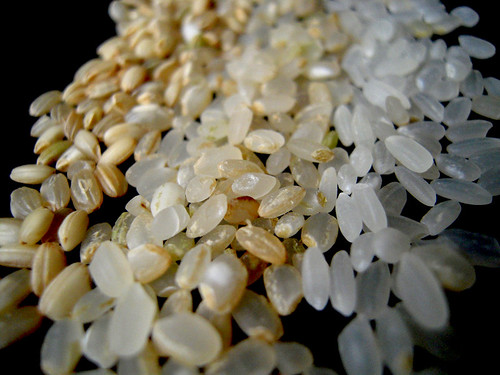
Rice has come up in conversation more than a few times since I have been back in the US. Mainly questions like "What kind of rice do you eat?" "Where do you buy your rice?" and "How does rice in the US compare to the rice in Japan?"
True, nothing compares to rice in Japan - but we don't have it so bad in the states either. I have been going wild trying all the new rice available to me in America - especially in the bulk section at the
Berkeley Bowl. But after all the experimenting, I have decided on a "house" brand available to me from the
local Japanese supermarket.
But first, the skinny on three short grain rice types:
Haku-mai (White Rice)
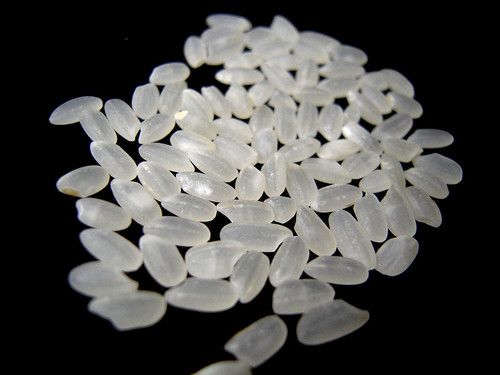
This is the stuff I grew up on and I think I grew up to be a pretty functional human being. For all the bad wrap that white (haku) rice is getting these days, I'd like to offer my love to it. It has less fiber than its counterparts below, but it has the luxuriously plump texture with the right amount of sweetness, making it the only rice delicate enough to be paired simply with a piece of raw fish as nigiri.
Because white rice is milled to the point where the husk, bran and germ is removed, it is quite delicate. Washing white rice 2 to 3 times before steaming is a must - just make sure you don't grind the rice into small bits while you are swishing it around in the washing process.
Dear white rice,
I will forever find a place in my cupboard for you, and thank you for being there for me always.
Gen-mai (Brown Rice)
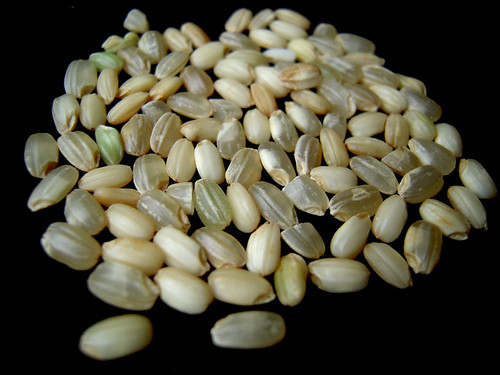
On the other side of the Japanese rice spectrum is
brown rice, or gen-mai. Brown rice can be excellent underneath a hearty stew, as an onigiri (riceball) or in a vegetarian roll. I have tried making California rolls with gen-mai and it was surprisingly excellent. I tried to establish gen-mai as my everyday staple rice three years ago in Tokyo but I gave up on it in about a month. The reason was simple - I just got bored of it. Because brown rice can be quite over-powering and you must really gnash at it to eat it, its presence is much more potent than white rice.
Brown rice is considered the healthiest out of the three types I am discussing here, because the bran and germ are preserved in the milling process. That means a lot of fiber and iron. The fiber to starch ratio is much higher in brown rice versus white rice, making brown rice much better for "passing" it along out of the body. One of the best things about brown rice is that you don't have to wash it before steaming! So, if you are a lazy, health nut (oxymoron?) brown rice is the way-to-go.
Be aware that brown rice goes bad much quicker than white rice because the oil bran layer can start to rot - therefore, take notice of the sell-by date on the package. Get rid of it if it starts to smell oily.
Haiga-mai (Germ Rice)
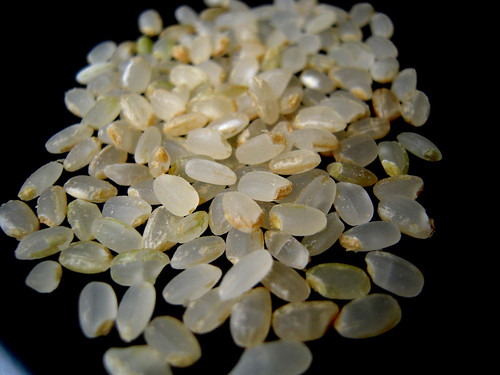
Haiga-mai is like the love child of Brown and White Rice. It's half-milled, so the bran layer is removed, but the germ (haiga) is intact. This allows for the plump texture of white rice but with a little "core" which is the germ. Haiga-mai is extremely flexible and I eat it for everything. It is delicate enough to accompany my lone umeboshi for breakfast, yet gives me the piece-of-mind that I am still getting a good amount of fiber from the germ.
Haiga-mai takes less time to cook than brown rice but must be washed 2 to 3 times with water, like white rice, before steaming. What's amazing about haiga-mai is that the taste is very similar to white rice, making it suitable for Japanese cooking, but
far surpasses white rice in nutrition in terms of fiber, vitamin E and B, niacin and calcium. I would apply one restriction to haiga-mai though - I would not recommend it for nigiri or pairing it with raw fish. For this event, I would insist on white rice for its delicate texture.
The verdict:
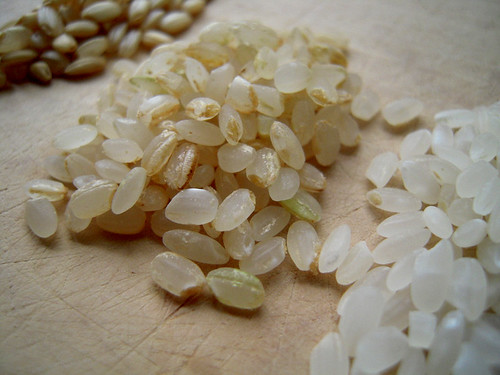
After much rice-searching, haiga-mai is the mainstay in our household. It's the best balance between taste and nutrition and I never feel like I am compromising a dish by using it. Our local Japanese grocer offers two types of haiga-mai from Kagayaki and
Tamaki. Kagayaki is the one we go with because it's cheaper.
Exploring different types of rice is fun and satisfying because it can be knowledge that can effect your pantry for the rest of its life. All rice is not created equal, and we have the privilege of finding that out here in the US.
 Rice has come up in conversation more than a few times since I have been back in the US. Mainly questions like "What kind of rice do you eat?" "Where do you buy your rice?" and "How does rice in the US compare to the rice in Japan?"
True, nothing compares to rice in Japan - but we don't have it so bad in the states either. I have been going wild trying all the new rice available to me in America - especially in the bulk section at the Berkeley Bowl. But after all the experimenting, I have decided on a "house" brand available to me from the local Japanese supermarket.
But first, the skinny on three short grain rice types:
Haku-mai (White Rice)
Rice has come up in conversation more than a few times since I have been back in the US. Mainly questions like "What kind of rice do you eat?" "Where do you buy your rice?" and "How does rice in the US compare to the rice in Japan?"
True, nothing compares to rice in Japan - but we don't have it so bad in the states either. I have been going wild trying all the new rice available to me in America - especially in the bulk section at the Berkeley Bowl. But after all the experimenting, I have decided on a "house" brand available to me from the local Japanese supermarket.
But first, the skinny on three short grain rice types:
Haku-mai (White Rice)
 This is the stuff I grew up on and I think I grew up to be a pretty functional human being. For all the bad wrap that white (haku) rice is getting these days, I'd like to offer my love to it. It has less fiber than its counterparts below, but it has the luxuriously plump texture with the right amount of sweetness, making it the only rice delicate enough to be paired simply with a piece of raw fish as nigiri.
Because white rice is milled to the point where the husk, bran and germ is removed, it is quite delicate. Washing white rice 2 to 3 times before steaming is a must - just make sure you don't grind the rice into small bits while you are swishing it around in the washing process.
Dear white rice,
I will forever find a place in my cupboard for you, and thank you for being there for me always.
Gen-mai (Brown Rice)
This is the stuff I grew up on and I think I grew up to be a pretty functional human being. For all the bad wrap that white (haku) rice is getting these days, I'd like to offer my love to it. It has less fiber than its counterparts below, but it has the luxuriously plump texture with the right amount of sweetness, making it the only rice delicate enough to be paired simply with a piece of raw fish as nigiri.
Because white rice is milled to the point where the husk, bran and germ is removed, it is quite delicate. Washing white rice 2 to 3 times before steaming is a must - just make sure you don't grind the rice into small bits while you are swishing it around in the washing process.
Dear white rice,
I will forever find a place in my cupboard for you, and thank you for being there for me always.
Gen-mai (Brown Rice)
 On the other side of the Japanese rice spectrum is brown rice, or gen-mai. Brown rice can be excellent underneath a hearty stew, as an onigiri (riceball) or in a vegetarian roll. I have tried making California rolls with gen-mai and it was surprisingly excellent. I tried to establish gen-mai as my everyday staple rice three years ago in Tokyo but I gave up on it in about a month. The reason was simple - I just got bored of it. Because brown rice can be quite over-powering and you must really gnash at it to eat it, its presence is much more potent than white rice.
Brown rice is considered the healthiest out of the three types I am discussing here, because the bran and germ are preserved in the milling process. That means a lot of fiber and iron. The fiber to starch ratio is much higher in brown rice versus white rice, making brown rice much better for "passing" it along out of the body. One of the best things about brown rice is that you don't have to wash it before steaming! So, if you are a lazy, health nut (oxymoron?) brown rice is the way-to-go.
Be aware that brown rice goes bad much quicker than white rice because the oil bran layer can start to rot - therefore, take notice of the sell-by date on the package. Get rid of it if it starts to smell oily.
Haiga-mai (Germ Rice)
On the other side of the Japanese rice spectrum is brown rice, or gen-mai. Brown rice can be excellent underneath a hearty stew, as an onigiri (riceball) or in a vegetarian roll. I have tried making California rolls with gen-mai and it was surprisingly excellent. I tried to establish gen-mai as my everyday staple rice three years ago in Tokyo but I gave up on it in about a month. The reason was simple - I just got bored of it. Because brown rice can be quite over-powering and you must really gnash at it to eat it, its presence is much more potent than white rice.
Brown rice is considered the healthiest out of the three types I am discussing here, because the bran and germ are preserved in the milling process. That means a lot of fiber and iron. The fiber to starch ratio is much higher in brown rice versus white rice, making brown rice much better for "passing" it along out of the body. One of the best things about brown rice is that you don't have to wash it before steaming! So, if you are a lazy, health nut (oxymoron?) brown rice is the way-to-go.
Be aware that brown rice goes bad much quicker than white rice because the oil bran layer can start to rot - therefore, take notice of the sell-by date on the package. Get rid of it if it starts to smell oily.
Haiga-mai (Germ Rice)
 Haiga-mai is like the love child of Brown and White Rice. It's half-milled, so the bran layer is removed, but the germ (haiga) is intact. This allows for the plump texture of white rice but with a little "core" which is the germ. Haiga-mai is extremely flexible and I eat it for everything. It is delicate enough to accompany my lone umeboshi for breakfast, yet gives me the piece-of-mind that I am still getting a good amount of fiber from the germ.
Haiga-mai takes less time to cook than brown rice but must be washed 2 to 3 times with water, like white rice, before steaming. What's amazing about haiga-mai is that the taste is very similar to white rice, making it suitable for Japanese cooking, but far surpasses white rice in nutrition in terms of fiber, vitamin E and B, niacin and calcium. I would apply one restriction to haiga-mai though - I would not recommend it for nigiri or pairing it with raw fish. For this event, I would insist on white rice for its delicate texture.
The verdict:
Haiga-mai is like the love child of Brown and White Rice. It's half-milled, so the bran layer is removed, but the germ (haiga) is intact. This allows for the plump texture of white rice but with a little "core" which is the germ. Haiga-mai is extremely flexible and I eat it for everything. It is delicate enough to accompany my lone umeboshi for breakfast, yet gives me the piece-of-mind that I am still getting a good amount of fiber from the germ.
Haiga-mai takes less time to cook than brown rice but must be washed 2 to 3 times with water, like white rice, before steaming. What's amazing about haiga-mai is that the taste is very similar to white rice, making it suitable for Japanese cooking, but far surpasses white rice in nutrition in terms of fiber, vitamin E and B, niacin and calcium. I would apply one restriction to haiga-mai though - I would not recommend it for nigiri or pairing it with raw fish. For this event, I would insist on white rice for its delicate texture.
The verdict:
 After much rice-searching, haiga-mai is the mainstay in our household. It's the best balance between taste and nutrition and I never feel like I am compromising a dish by using it. Our local Japanese grocer offers two types of haiga-mai from Kagayaki and Tamaki. Kagayaki is the one we go with because it's cheaper.
Exploring different types of rice is fun and satisfying because it can be knowledge that can effect your pantry for the rest of its life. All rice is not created equal, and we have the privilege of finding that out here in the US.
After much rice-searching, haiga-mai is the mainstay in our household. It's the best balance between taste and nutrition and I never feel like I am compromising a dish by using it. Our local Japanese grocer offers two types of haiga-mai from Kagayaki and Tamaki. Kagayaki is the one we go with because it's cheaper.
Exploring different types of rice is fun and satisfying because it can be knowledge that can effect your pantry for the rest of its life. All rice is not created equal, and we have the privilege of finding that out here in the US.


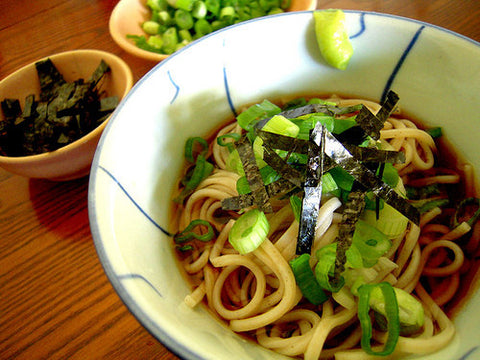

Comments (9)
Great information, thanks! I am in Hokkaido and just bought genmai for the first time, at Costco. You know that most of bread available here is white bread and I am always reading to eat whole grain for the fiber etc. But so hard to get in a small town in Japan.
You mentioned in the post that haiga-mai should be washed 2-3 times. I’m always curious about that number, since some say to wash until the water is clear. Washing 2-3 times, would it produce a clear water?
Haigamai is at its best up to 6 months after opening. But I have kept mine for up to 12 month in an air tight container.
Hello,
Do you know how long the hagamai will last? I eat by myself so that thing is important for me
Thanks
Dear White Rice,
There was a huge craze in Japan a few years back where different rice breeds and “browner” grains with funky names were all the rage. Hideko, forever on the JapanCraze bandwagon, sent me a boxful of these colorful, “nutritious” grains when I lived in NYC.
I never opened any of them. Sorry, Mama!
You are my #1 breed of rice, and like Yoko, will always have a spot in my cupboard.
Love,
Kayoko
My sis mixed in a bag of brown rice into the white rice bucket so we had a mix for a few months. That worked out pretty well. I do like haiga-mai, though. Good to know Tokyo Fish stocks it.
Yeah I did that for a while too! http://www.umamimart.com/2009/06/Half-and-Half-Rice/
Where can I buy Haigamai rice. I am in Lincoln California 95648
I have often read that white rice should never be washed, because it is (in USA, at least), “enriched” — it has vitamins added, to make up for the loss when the rice is milled. From what I have read, these added vitamins will be removed if white rice is washed.
BTW, my staple is brown Basmati rice, imported from India, which I buy in “large” (10 or 12 lbs) burlap sacks. It is my main course for all of my daily meals. I find it delicious, so much so that I must force myself to avoid over-eating. I do wash it several times, to help reduce the starchy dust.